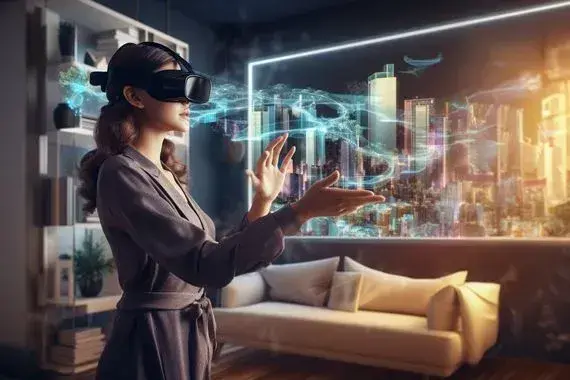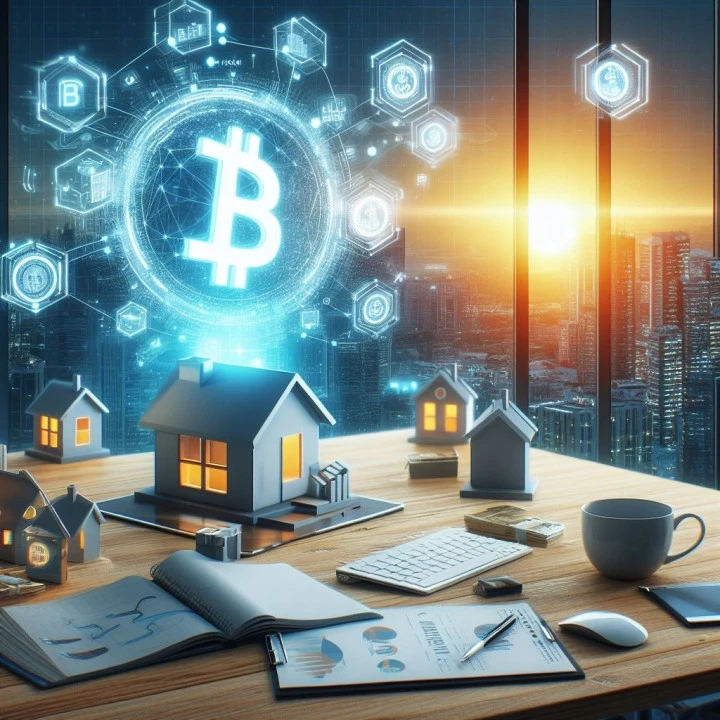In the realm of real estate, technological advancements continue to reshape traditional practices, and among the most transformative are Virtual Reality (VR) and Augmented Reality (AR). These immersive technologies are revolutionizing how properties are marketed, showcased, and sold, offering potential buyers and investors unprecedented experiences and insights into prospective homes and developments. This article explores the profound impact of VR and AR on the real estate industry, examining their applications, benefits, challenges, and future implications.
Contents
1. Understanding Virtual Reality (VR) and Augmented Reality (AR)
Before delving into their impact on real estate, it’s essential to grasp what VR and AR entail and how they differ:
Virtual Reality (VR)
VR technology creates a fully immersive, computer-generated environment that users can interact with using specialized equipment, such as VR headsets. Users wearing VR headsets are transported to virtual environments that simulate real-world scenarios, allowing them to explore and interact with digital spaces as if they were physically present.
Augmented Reality (AR)
AR technology overlays digital information or virtual objects onto the real-world environment, typically viewed through a smartphone or AR glasses. AR enhances the user’s perception of reality by adding computer-generated elements, such as text, images, or 3D models, that interact with the physical surroundings in real-time.
2. Applications of VR and AR in Real Estate Marketing
VR and AR technologies are transforming how real estate properties are marketed, offering immersive experiences that go beyond traditional photographs and videos. Here’s how VR and AR are changing the landscape of real estate marketing:
Virtual Property Tours
One of the most significant applications of VR in real estate is virtual property tours. VR allows potential buyers and investors to explore properties remotely and in immersive detail. Using VR headsets, users can navigate through virtual homes, inspecting rooms, layouts, and finishes as if they were physically present. This immersive experience gives buyers a comprehensive understanding of the property’s spatial layout and design, enhancing their decision-making process.
Case Study: Matterport
Matterport, a leading provider of 3D virtual tour technology, enables real estate professionals to create interactive and realistic virtual tours of properties. Using Matterport’s cameras and software, agents can capture 3D scans of homes and generate immersive virtual tours that prospective buyers can explore online or through VR headsets. Matterport’s technology enhances property visibility, engagement, and leads to faster sales cycles.
Virtual Staging and Renovation
VR and AR technologies allow real estate professionals to virtually stage properties and showcase potential renovations or interior design changes. Virtual staging involves digitally furnishing empty rooms with virtual furniture and decor, allowing buyers to visualize the property’s potential and layout possibilities. Similarly, AR apps enable users to view different paint colors, flooring options, or furniture arrangements overlaid onto their physical surroundings, helping them envision customization options.
Interactive Property Showcases
AR enhances traditional property listings by overlaying digital information onto physical spaces. Using AR-enabled smartphones or tablets, potential buyers can point their device’s camera at a property listing or a real-world location to access additional information, such as property details, pricing, and nearby amenities. This interactive experience enhances engagement and provides buyers with contextual information in real-time.
3. Benefits of VR and AR in Real Estate Sales
The adoption of VR and AR technologies in real estate offers numerous benefits for both buyers and sellers. Here are the key advantages:
Enhanced Visualization and Decision-Making
VR and AR provide buyers with immersive and realistic experiences that traditional photos and videos cannot replicate. By virtually touring properties and visualizing potential modifications, buyers can make informed decisions based on a thorough understanding of the property’s layout, condition, and customization options. This enhanced visualization capability reduces uncertainty and accelerates the decision-making process.
Global Reach and Accessibility
VR and AR technologies transcend geographical barriers, allowing international buyers and investors to explore properties remotely. Virtual tours and AR-enhanced listings enable real estate professionals to showcase properties to a global audience, increasing visibility and attracting potential buyers from diverse markets. This global reach expands market opportunities and facilitates cross-border real estate transactions.
Cost and Time Savings
Virtual property tours and virtual staging minimize the need for physical property visits and traditional staging efforts, reducing logistical costs and time-consuming scheduling conflicts. Sellers can showcase properties to multiple buyers simultaneously through VR tours, streamlining the sales process and accelerating transaction timelines. Similarly, AR-enhanced property listings provide detailed information instantly, eliminating the need for multiple in-person visits.
Case Study: Sotheby’s International Realty
Sotheby’s International Realty utilizes VR and AR technologies to enhance its luxury property marketing efforts. The firm offers virtual property tours and AR-enabled property showcases that enable potential buyers to experience high-end homes and estates from anywhere in the world. Sotheby’s VR and AR initiatives enhance property visibility, engagement, and facilitate cross-border transactions in the luxury real estate market.
4. Challenges and Considerations
While VR and AR offer transformative benefits for real estate marketing and sales, their adoption also presents challenges and considerations that must be addressed:
Cost of Technology Implementation
Deploying VR and AR technologies requires initial investment in hardware, software, and specialized equipment, such as VR headsets and 3D cameras. Real estate professionals and agencies must evaluate the cost-benefit ratio and consider the long-term value of enhancing property marketing through immersive technologies.
User Experience and Adoption
Ensuring a seamless and intuitive user experience is crucial for the widespread adoption of VR and AR in real estate. Buyers and investors may require training or technical support to navigate virtual tours or AR applications effectively. Real estate professionals must prioritize usability, accessibility, and user-friendly interfaces to maximize engagement and satisfaction.
Content Creation and Quality
Creating high-quality VR and AR content requires expertise in 3D modeling, photography, and virtual staging. Real estate agencies may need to collaborate with professional photographers, videographers, or virtual tour providers to capture accurate and visually appealing representations of properties. Maintaining content consistency and ensuring accuracy in virtual representations are essential for building buyer trust and credibility.
Privacy and Data Security
VR and AR technologies collect and process sensitive data, such as property layouts, personal preferences, and user interactions. Real estate professionals must implement robust data privacy measures, secure storage solutions, and encryption protocols to protect confidential information and adhere to regulatory requirements, such as GDPR and CCPA.
5. Future Trends and Innovations
The future of VR and AR in real estate is poised for continued growth and innovation, driven by advancements in technology and evolving market demands. Here are some emerging trends and developments to watch:
Integration with Artificial Intelligence (AI)
The integration of AI algorithms with VR and AR technologies can personalize property recommendations, predict buyer preferences, and enhance virtual tour experiences. AI-powered chatbots and virtual assistants can provide real-time property information, schedule virtual tours, and answer buyer inquiries, improving customer engagement and satisfaction.
Extended Reality (XR) Experiences
Extended Reality (XR) combines VR, AR, and mixed reality (MR) technologies to create immersive and interactive experiences that blend virtual and physical environments seamlessly. XR enables real estate professionals to offer dynamic property showcases, interactive virtual tours, and immersive storytelling experiences that captivate buyers and differentiate listings in competitive markets.
Blockchain and Digital Transactions
Blockchain technology can enhance the security, transparency, and efficiency of real estate transactions conducted through VR and AR platforms. Smart contracts powered by blockchain enable automated property transfers, secure payments, and transparent record-keeping, simplifying transaction processes and reducing friction in real estate transactions.
Case Study: Zillow’s Virtual Tours
Zillow, a leading online real estate marketplace, utilizes VR technology to offer virtual property tours and immersive 3D home walkthroughs. Zillow’s VR initiatives enable potential buyers to explore listed properties in detail, visualize layout configurations, and experience homes from different perspectives. Zillow’s VR tours enhance property visibility, engagement, and facilitate remote property exploration.
Virtual Reality (VR) and Augmented Reality (AR) technologies are reshaping the landscape of real estate marketing and sales, offering immersive experiences that enhance property visibility, engagement, and transaction efficiency. From virtual property tours and AR-enhanced listings to virtual staging and extended reality (XR) experiences, VR and AR empower real estate professionals to showcase properties effectively and cater to diverse buyer preferences.
While challenges such as technology costs, user adoption, and data privacy must be navigated, the potential of VR and AR to transform real estate marketing and sales is undeniable. By embracing immersive technologies, real estate agencies can differentiate listings, attract global buyers, and streamline transaction processes, positioning themselves at the forefront of innovation in the competitive real estate market.
The future of VR and AR in real estate holds exciting possibilities, with ongoing advancements and innovations poised to further enhance buyer experiences, drive digital transformation, and redefine industry standards. As technology continues to evolve, real estate professionals must adapt, innovate, and leverage VR and AR to unlock new opportunities and deliver exceptional value to buyers and investors in the digital age.


